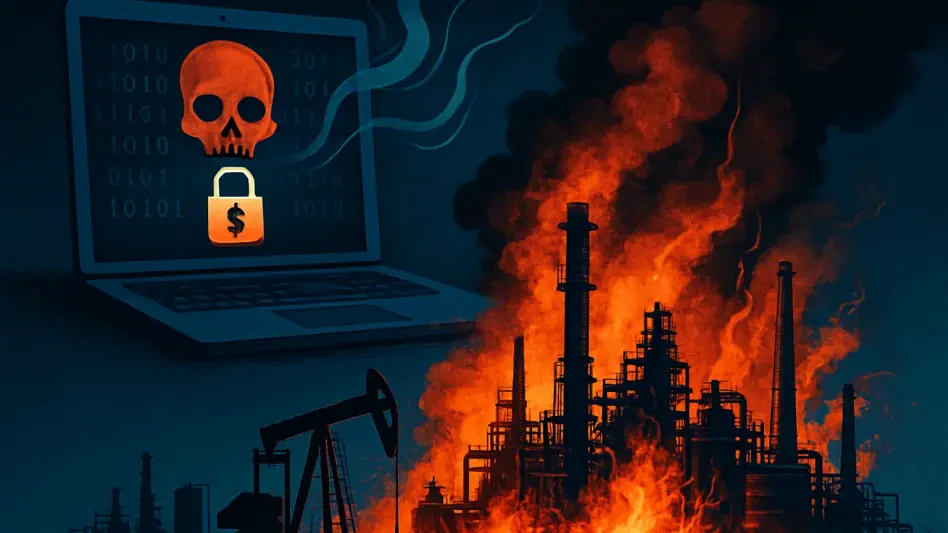What happens when the backbone of global energy—oil and gas—becomes a battlefield for cybercriminals? A staggering 935% surge in ransomware attacks on this critical sector has sent shockwaves through industries and economies alike, exposing vulnerabilities that could disrupt fuel supplies and spike prices overnight. As digital threats evolve at an unprecedented pace, the stakes have never been higher for the infrastructure that powers daily life. This alarming trend, revealed by a leading cybersecurity firm, demands urgent attention from industry leaders, policymakers, and the public. Dive into the escalating crisis and uncover why the energy sector is under siege like never before.
The Heart of the Matter: Why This Surge Threatens Everyone
The dramatic rise in ransomware attacks on oil and gas isn’t just a niche cybersecurity concern—it’s a global risk with far-reaching consequences. A disruption in this sector can halt production, delay shipments, and cause energy prices to soar, impacting everything from heating homes to fueling transportation. With economies and livelihoods hanging in the balance, the 935% increase signals a dire need for action. Beyond the numbers, this crisis reflects a broader vulnerability in critical infrastructure, where digital transformation has outpaced security measures, leaving gaping holes for attackers to exploit.
This issue extends beyond industry boardrooms, touching the lives of everyday people who rely on stable energy supplies. The urgency to address these threats stems from their potential to cascade into economic instability and even national security risks. As cybercriminals grow bolder, targeting the lifeblood of modern society, understanding and mitigating these dangers becomes a shared responsibility across public and private sectors.
Critical Infrastructure in the Crosshairs: Oil and Gas at Risk
The oil and gas industry has emerged as a prime target for ransomware due to its strategic importance and inherent weaknesses. Increased automation in rigs, pipelines, and refineries has expanded the digital attack surface, while outdated security systems provide easy entry points for attackers. These vulnerabilities are exploited with ruthless precision, as disruptions in this sector can grind operations to a halt, creating ripple effects across global markets.
Unlike other industries, the stakes here are uniquely high. A single breach can lead to supply chain interruptions, environmental hazards, and massive financial losses. Cybercriminals understand this leverage, often demanding exorbitant ransoms knowing that companies may pay to avoid catastrophic downtime. The scale of the problem is evident in the sheer volume of attacks, with the sector experiencing an unprecedented spike that dwarfs increases in other fields.
Comparatively, sectors like healthcare and manufacturing also face significant threats, with attack rises of 115% and notable impacts respectively. However, oil and gas stands out due to its role as an economic cornerstone. The convergence of technological reliance and inadequate defenses paints a troubling picture, highlighting the urgent need for tailored protections in this vital industry.
Dissecting the Threat: How Ransomware Tactics Are Evolving
Behind the staggering 935% surge lies a rapidly shifting ransomware landscape, marked by innovative and destructive tactics. Attackers no longer rely solely on encrypting systems; data theft has become the dominant extortion method, with 238.5 terabytes of data stolen by major ransomware families in a single year—a 92.7% increase. Public leak sites, seeing a 70.1% uptick in usage, add reputational damage to financial pressure, forcing victims into impossible choices.
Geographically, the United States bears the brunt, accounting for 50.8% of global attacks with over 3,600 incidents. This focus on digitally mature economies maximizes impact, as seen with groups like RansomHub, which claimed 833 victims through sophisticated supply chain attacks. These methods exploit interconnected systems, turning a single breach into a widespread crisis that can paralyze entire networks.
The speed and adaptability of these threats are staggering. Automation vulnerabilities in oil and gas infrastructure, combined with weak access controls, create a perfect storm for exploitation. As tactics evolve, attackers continuously refine their approaches, using stolen data not just for ransom but also for secondary markets, amplifying the long-term damage to targeted industries.
Voices from the Frontline: Experts Weigh In on Emerging Dangers
Cybersecurity experts are sounding the alarm on how ransomware is becoming smarter, not just more frequent. “Generative AI is revolutionizing attacks, automating everything from phishing to data extraction,” warns a leading researcher from a prominent threat analysis team. This technology enables cybercriminals to craft highly convincing scams, including voice-based phishing with AI-generated audio, predicted to dominate strategies by 2027.
The implications are chilling for industries like oil and gas, where a single deceptive call could trick an employee into granting access to critical systems. Such breaches can lead to weeks of downtime, costing millions and endangering supply chains. Real-world cases, like phishing campaigns that have infiltrated energy firms, underscore the growing sophistication of social engineering tactics powered by artificial intelligence.
Global efforts to counter these threats show some progress, with operations like collaborative takedowns disrupting major malware platforms. Yet, the resilience of threat actors remains a hurdle, as groups rebrand and adapt swiftly to enforcement actions. This cat-and-mouse dynamic illustrates the complexity of defending against an enemy that evolves with every setback, keeping experts and industries on edge.
Building Defenses: Strategies to Shield Vital Sectors
Safeguarding oil and gas from ransomware requires a multifaceted approach that addresses both technological and human vulnerabilities. Modernizing legacy systems is a critical first step—patching outdated software and strengthening access controls can close many of the gaps attackers exploit. Automation, while essential for efficiency, must be paired with robust security to prevent it from becoming a liability.
Adopting zero-trust security models offers another layer of protection, limiting an attacker’s ability to move within networks after a breach. Equally important is employee training to recognize AI-enhanced phishing, especially as voice cloning emerges as a deceptive tool. Companies must equip staff with the skills to identify and report suspicious activity before it escalates into a full-blown crisis.
Collaboration is also key, with public-private partnerships providing access to free tools and threat intelligence. Encrypting sensitive data and maintaining offline backups further reduce the leverage of data theft extortion. These actionable steps, customized to the unique challenges of critical infrastructure, form a blueprint for resilience against the relentless wave of digital threats facing the sector today.
Reflecting on a Battle Fought and Lessons Learned
Looking back, the dramatic 935% surge in ransomware attacks on oil and gas served as a stark reminder of the fragility of critical infrastructure in a digital age. Each breach exposed not just technical weaknesses but also the profound economic and societal risks tied to energy security. The battle against cybercriminals revealed both the ingenuity of attackers and the determination of defenders who strove to protect vital systems.
Moving forward, industries must prioritize sustained investment in cybersecurity, from updating outdated systems to fostering global cooperation. The path ahead demands innovation—embracing cutting-edge defenses like zero-trust architectures while preparing for AI-driven threats that loom on the horizon. By learning from past vulnerabilities, stakeholders aim to build a future where energy supplies remain secure, no matter the digital dangers that emerge.








